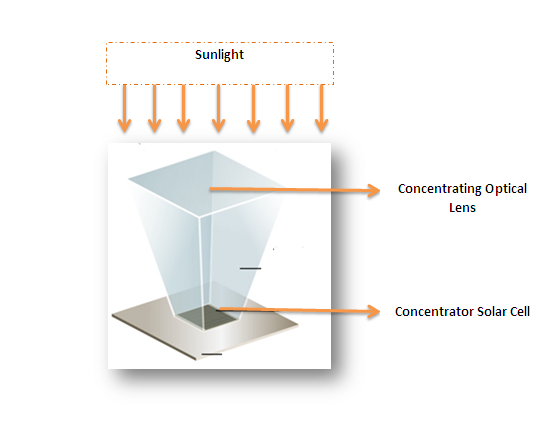Summary: Concentrating PV technology concentrates more sunlight onto a unit area of solar cells, resulting in much higher efficiency of sunlight conversion to electricity.
An interesting way to significantly increase the efficiency of solar cells is to concentrate the light that falls on them. How do these concentrating solar cells work, and by how much more can we increase the efficiency by concentrating sunlight?
Concentrating PV technology (CPV for short) typically uses lenses to concentrate a large amount of sunlight onto a small area of solar PV cells to generate electricity.

Recall that conventional solar cells do not have any concentrating lenses – they generate electricity based on the normal sunlight falling on them. The conventional cells have just a glass and encapsulant to protect them, but otherwise they just have sunlight falling on them at the same intensity as you and I experience sunlight.
Intensity of light falling on CPV cells are much higher compared to the intensity falling on a conventional solar cell. This results in a much higher efficiency for CPV cells.
CPV solar cells are fundamentally different in the way they operate – the intensity of light falling on CPV cells are much higher (actually much, much higher) compared to the amount of light falling on a conventional solar cell. This increased concentration of light, which is done using high purity lenses along with precise tracking systems, results in much higher efficiency.
Let us explain CPV a bit differently.
Lets say “1 sun” is the amount of energy from sunlight that falls on a unit area. Typically, on a cloudless day, this is about 100 W per sqft (1000 W per sqm). CPV technology, by concentrating more sunlight on the same area, is today able to produce “100 suns” or more – that is, get about 100 times the sunlight energy focussed on the same area that earlier was exposed to just “1 sun”.
You might ask: By shining more light on the same area, will the solar cells produce more electricity than otherwise? Yes, and that is the beauty. The solar cells produce more electricity under concentrated sunlight than under conventional sunlight as the efficiency increases significantly under concentrated light.
While conventional solar cells have hit a maximum of about 22% efficiency as of mid 2014, CPV solar cells have already shown efficiency of up to 35% in real life in the same timeline.
The higher efficiency implies that, compared to conventional solar cells, CPV systems can provide higher electricity output for the same area, since a smaller area of photovoltaic material is required for the same amount of electricity generation. This can be a significant advantage for countries where land availability for solar power plants is limited. The CPV could also be attractive to rooftop solar power plants as roof areas are normally limited, resulting in lesser energy generation than what the building might require.
CPV systems are however more expensive than conventional solar cells. This is because, in order to achieve these higher efficiency, CPVs can use the more expensive high-efficiency tandem solar cells.

Questions from the curious cat
What is the highest efficiency possible with CPV?
In labs and in select conditions, CPV systems have shown efficiencies of up to 40%. Much higher efficiencies are possible, with some companies claiming they can produce commercial CPV with efficiency above 50% by 2017.
What is the highest amount of concentration possible with CPV?
There might not be a theoretical maximum for the number of suns. However, material science limitations might constrain the practical maximum to less than 1500 suns – that is, 1500 times the concentration available for conventional cells.
What are the main components of a CPV?
The main components of a solar CPV system include:
- Panels comprising multiple junction solar cells
- Concentrating Lens
- Tracker system
- Balance of systems – such as mounting structure, inverters and other electrical components
What is the cost of a CPV system?
As of 2014, a CPV based solar power system costs about 1.75-2.5 times as much as a conventional solar power system. Thus, if the cost of a conventional 1 MW solar power plant is 2 million, a CPV power plant of 1 MW will cost between $3.5-5 million
Some nice videos for you
A demonstration of installed CPV systems by SolFocus
Contribute to Suncyclopedia – We wish to make Suncyclopedia a compendium of high quality content and insights, and are keen to add inputs from solar experts worldwide. If you wish to share any fact or insight about this topic, do send it to feedback@suncyclopedia.com ; if we find it useful, we will surely add it here and make sure we give you credits for it too! Look forward to hearing from you – Team Suncyclopedia

 Skip to content
Skip to content
